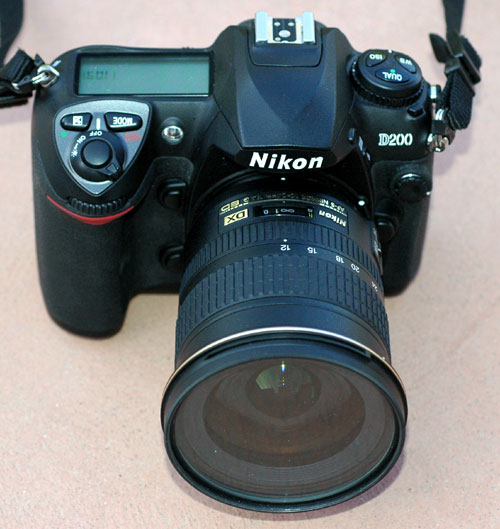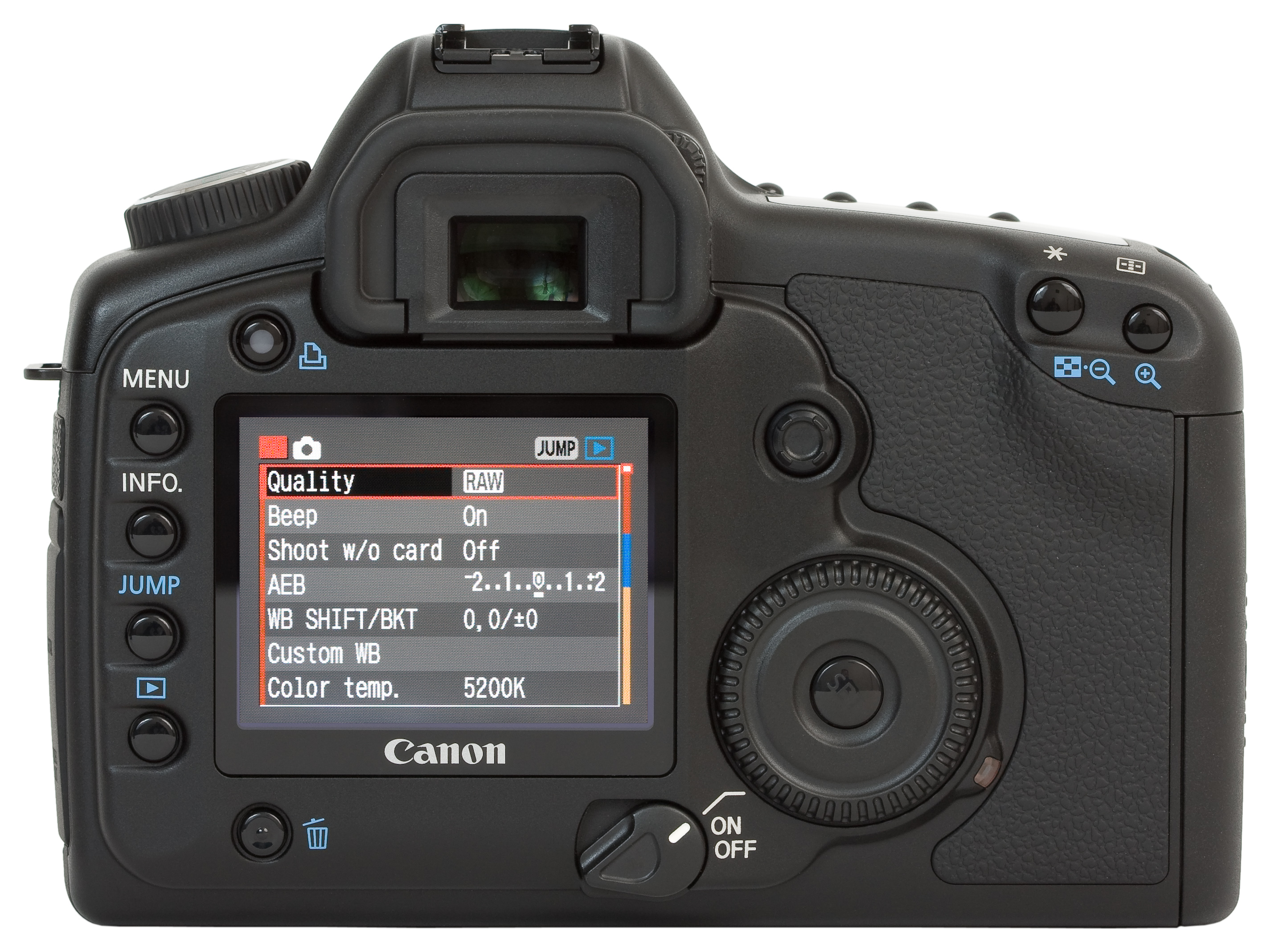|
Nikon D2X
The Nikon D2X is a 12.4-megapixel professional digital single-lens reflex camera (DSLR) that Nikon Corporation announced on September 16, 2004. The D2X was the high-resolution flagship in Nikon's DSLR line until June 2006 when it was supplanted by the D2Xs and, in time, the Nikon D3 range, Nikon D4 range and Nikon D5 — the latter three using a FX full-format sensor. Technology The D2X uses a DX-format CMOS sensor supplied by Sony instead of either a charge-coupled device or the Nikon proprietary LBCAST sensor which had both dominated Nikon's digital SLR lineup until the D2X. The camera supports the sYCC color space. The CMOS sensor used in the D2X has the ability to resolve about nine times more than the human eye. At 90 line pairs/millimeter (90 lp/mm), the sensor can resolve extremely fine detail. This makes the camera perform exceptionally well when used as a landscape or scenic imager, since it can better resolve smaller detail in distant objects. The D2X surpasse ... [...More Info...] [...Related Items...] OR: [Wikipedia] [Google] [Baidu] |
Digital Single-lens Reflex Camera
A digital single-lens reflex camera (digital SLR or DSLR) is a digital camera that combines the optics and the mechanisms of a single-lens reflex camera with a digital imaging sensor. The reflex design scheme is the primary difference between a DSLR and other digital cameras. In the reflex design, light travels through the lens and then to a mirror that alternates to send the image to either a prism, which shows the image in the viewfinder, or the image sensor when the shutter release button is pressed. The viewfinder of a DSLR presents an image that will not differ substantially from what is captured by the camera's sensor as it presents it as a direct optical view through the main camera lens, rather than showing an image through a separate secondary lens. DSLRs largely replaced film-based SLRs during the 2000s. Major camera manufacturers began to transition their product lines away from DSLR cameras to mirrorless interchangeable-lens cameras (MILC) beginning in the 2010s ... [...More Info...] [...Related Items...] OR: [Wikipedia] [Google] [Baidu] |
Nikon D2H
The Nikon D2H is a professional-grade digital single-lens reflex camera introduced by Nikon Corporation on July 22, 2003. It uses Nikon's own JFET-LBCAST sensor with a 4.1-megapixel resolution, and is optimised for sports and action shooting that require a high frame rate. In 2005, the D2H was replaced by the D2Hs, which added new features derived from the 12-megapixel D2X digital SLR. The D2Hs was discontinued after the introduction of the D300 and D3 models. Like most early Nikon Digital SLR cameras, it uses a "DX Format" sensor, which applies a crop factor compared to 35 mm film of approximately 1.5×. D2Hs The D2Hs was announced on February 16, 2005, adding several improvements to the D2H design, although with the same sensor and body. Nikon added an improved light metering system, faster subject acquisition and tracking algorithms to the Multi-CAM-2000 Autofocus module, and expanded both the JPEG and RAW continuous shooting buffer. Nikon also reported improved n ... [...More Info...] [...Related Items...] OR: [Wikipedia] [Google] [Baidu] |
Nikon F-mount Cameras
(, ; ), also known just as Nikon, is a Japanese multinational corporation headquartered in Tokyo, Japan, specializing in optics and imaging products. The companies held by Nikon form the Nikon Group. Nikon's products include cameras, camera lenses, binoculars, microscopes, ophthalmic lenses, measurement instruments, rifle scopes, spotting scopes, and the steppers used in the photolithography steps of semiconductor fabrication, of which it is the world's second largest manufacturer. The company is the eighth-largest chip equipment maker as reported in 2017. Also, it has diversified into new areas like 3D printing and regenerative medicine to compensate for the shrinking digital camera market. Among Nikon's many notable product lines are Nikkor imaging lenses (for F-mount cameras, large format photography, photographic enlargers, and other applications), the Nikon F-series of 35 mm film SLR cameras, the Nikon D-series of digital SLR cameras, the Nikon Z-series of digital mirro ... [...More Info...] [...Related Items...] OR: [Wikipedia] [Google] [Baidu] |
Nikon D200
The Nikon D200 is a 10.2-megapixel digital single-lens reflex camera that falls between entry-level/midrange DSLR cameras such as the Nikon D40, Nikon D40x, and D80 and high-end models such as the Nikon D2Hs and D2Xs. It was released by the Nikon Corporation in November 2005. The D200 was succeeded by the D300 in August 2007. Comparison with other Nikon models Main advantages over the D40, D40x, D50, D60 and D80 cameras include: * More robust, metal (magnesium alloy) body incorporating environmental seals * Better matrix metering than D40, D50, or D80 (more sensor areas and less prone to overexposure) * Higher image resolution than D50 and D40, 10 MP instead of 6 MP (Note that the D40x and D60 are 10.2 MP) * 11-point autofocus system instead of a 3-point system (D40, D40x and D60) * Advanced continuous autofocus tracking options * More straightforward controls; many controls to adjust shooting settings (image quality, ISO, etc.) are directly accessible on the camera without g ... [...More Info...] [...Related Items...] OR: [Wikipedia] [Google] [Baidu] |
European Imaging And Sound Association
Expert Imaging and Sound Association is a collaboration between different multimedia magazines, that offer tests of cameras, videocameras, audio equipment, mobile phones, etc. The organization was established in 1982. The current president of EISA is Paul Miller. In 2018, the organisation was renamed as the Expert Imaging and Sound Association (formerly European Imaging and Sound Association) to reflect new members from outside the European area, including Australian magazines Sound+Image and Australian Hi-Fi, and US magazines Stereophile and Sound and Vision. External links EISA Organizations established in 1982 Pan-European trade and professional organizations 1982 establishments in Europe {{europe-org-stub ... [...More Info...] [...Related Items...] OR: [Wikipedia] [Google] [Baidu] |
Nikon D700
The Nikon D700 is a professional-grade full-frame digital single-lens reflex camera introduced by the Nikon Corporation in July 2008 and manufactured in Japan. It uses the same 12.1-megapixel "FX" CMOS image sensor as the Nikon D3, and is Nikon's second full-frame digital SLR camera. The D700's full-frame sensor allows the use of F-mount (FX) lenses to their fullest advantage, with almost no crop factor. When a cropped DX lens is mounted on the D700, either the DX-sized portion, or the (vignetted) FX-sized portion of the camera's sensor can be used. The D700 has a built in autofocus motor for all Nikon autofocus-lenses, includes CPU and metering for older Nikon F-mount AI/AI-S lenses, and supports PC-E lenses. The D700 bears a physical similarity to the Nikon D300, which uses the same MB-D10 battery pack and EN-EL3e battery. As of 2012, the Nikon D3X, the D3/ D3s, D4 and D700 were the only Nikon DSLR models manufactured in Japan. It was discontinued on August 24, 2012. Fe ... [...More Info...] [...Related Items...] OR: [Wikipedia] [Google] [Baidu] |
Full Frame Digital SLR
A full-frame DSLR is a digital single-lens reflex camera (DSLR) with a 35 mm image sensor format (). Historically, 35 mm was one of the standard film formats, alongside larger ones, such as medium format and large format. The full-frame DSLR is in contrast to full-frame mirrorless interchangeable-lens cameras, and DSLR and mirrorless cameras with smaller sensors (for instance, those with a size equivalent to APS-C-size film), much smaller than a full 35 mm frame. Many digital cameras, both compact and SLR models, use a smaller-than-35 mm frame as it is easier and cheaper to manufacture imaging sensors at a smaller size. Historically, the earliest digital SLR models, such as the Nikon NASA F4 or Kodak DCS 100, also used a smaller sensor. Kodak states that 35 mm film (note: in "Academy format", 21.0 mm × 15.2 mm) has the equivalent of 6K horizontal resolution, according to a senior vice president of IMAX. This equates to 10K horizontal resolution in full ... [...More Info...] [...Related Items...] OR: [Wikipedia] [Google] [Baidu] |
Canon EOS 5D
The Canon EOS 5D is a 12.8 megapixel digital single-lens reflex (DSLR) camera body produced by Canon. The EOS 5D was announced by Canon on 22 August 2005, and at the time was priced above the EOS 20D but below the EOS-1D Mark II and EOS-1Ds Mark II in Canon's EOS digital SLR series. The camera accepts EF lens mount lenses. The EOS 5D is notable for being the first full-frame DSLR camera with a standard body size (as opposed to the taller, double-grip "professional" camera body style). It is also notable for its price, suggested at US$3299 without lens, which set a significant new low price point for full-frame DSLRs; its only full-frame competition at the time was the Canon 1Ds Mark II, which cost more than twice as much. On 17 September 2008, Canon announced the camera's successor, the Canon EOS 5D Mark II. Features Sensor and image processing The 5D has a DIGIC II processor and a 35.8 x 23.9 mm full-frame CMOS sensor with 13.3 million pixels (12.7 megapixel ef ... [...More Info...] [...Related Items...] OR: [Wikipedia] [Google] [Baidu] |
Canon EOS-1D Mark II
The EOS 1D Mark II is a professional 8.2 megapixel digital single lens reflex camera (DSLR) camera body produced by Canon. The EOS 1D Mark II was the successor of the EOS 1D and was itself replaced by the Canon EOS-1D Mark III in 2007. It was Canon's first dual-card slot EOS camera with one CF slot and one SD slot that was meant easily to use two dominant card types and have a assurance that once a small sized primary and faster CF slot is full, camera can be used to take photographs when recording was continued on secondary and slower card in critical moment. It also now had wireless capabilities. When paired with the neCanon WFT-E1 you could transfer images to a PC using an FTP server. Features The EOS 1D Mark II features: * 28.7 × 19.1 mm CMOS sensor * 8.2 megapixel effective (8.5 megapixel total) * DIGIC II image processor * Canon EF lens mount (excludes EF-S) * 1.3x crop factor * 45-point TTL-AREA-SIR autofocus with a dedicated CMOS sensor * TTL full aperture ... [...More Info...] [...Related Items...] OR: [Wikipedia] [Google] [Baidu] |
Canon EOS-1Ds Mark II
The EOS-1Ds Mark II is a digital SLR camera body introduced by Canon Inc. in 2004. It was the top model in the Canon EOS line of digital cameras until April 2007, with a full-frame 16.7 megapixel CMOS sensor. The EOS-1Ds Mark II had the highest pixel count available in a 35mm format digital SLR at the time of its introduction until its successor was announced in August 2007. It uses the EF lens mount. The EOS-1Ds Mark II is a professional grade camera body and is large, ruggedly built, and dust/weather-resistant. Being an autofocus camera, it has multiple autofocus modes and uses a 45-point autofocus system, and an option for manual focusing. Its viewfinder is a "fixed pentaprism". It also has a 2", TFT color LCD A liquid-crystal display (LCD) is a flat-panel display or other electronically modulated optical device that uses the light-modulating properties of liquid crystals combined with polarizers. Liquid crystals do not emit light directly but in .... Its dim ... [...More Info...] [...Related Items...] OR: [Wikipedia] [Google] [Baidu] |




